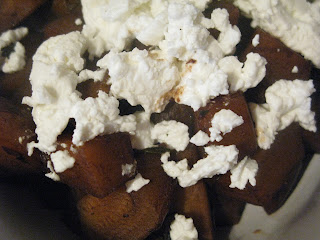A few weeks ago I celebrated a friend's birthday at a Mediterranean restaurant where you order several small dishes per person. I ate several delicious items. Their beet salad was particularly delicious. It was dressed with a balsamic reduction, arugula, and a creamy goat cheese. I omitted the arugula in my version for no particular reason.
I used some beautiful, pale beets that I bought for an exorbitant price at a farmers market. These beets are the roots of the beet plant. I have eaten beet leaves before, but these guys came san leaves.
During World War I, some Europeans only ate beets which lead to mangelwurzel disease. I'm not sure what that disease entails, but it has so many consonants it must be serious. Beets are a good source of folate and manganese.
Chevre is French for goat cheese. Goat milk has more fatty acids than cow milk so goat cheese is more tart. Goat cheese has been made for thousands of years. Some believe it was the first type of cheese produced. The simplest way to make goat cheese is to allow raw goat milk to curdle and then press the liquid out of the curds.
The ingredients are 2 large beets, 1/2 cup balsamic vinegar, 1 teaspoon fresh thyme, 1 teaspoon salt, and chevre cheese.
I covered the beets with water and simmered them in heavily salted water for 40 minutes.
I simmered the balsamic vinegar and fresh thyme for 15 minutes.
I pealed and chopped the cooked beets.
I added the beats and salt to the reduced balsamic vinegar. I let the balsamic vinegar and beats simmer together for five minutes.
I added chevre cheese onto each serving.
The goat cheese was tart and creamy. The thyme was fresh and aromatic.
It was a pleasant and flavorful combination. I would make it again.





















No comments:
Post a Comment